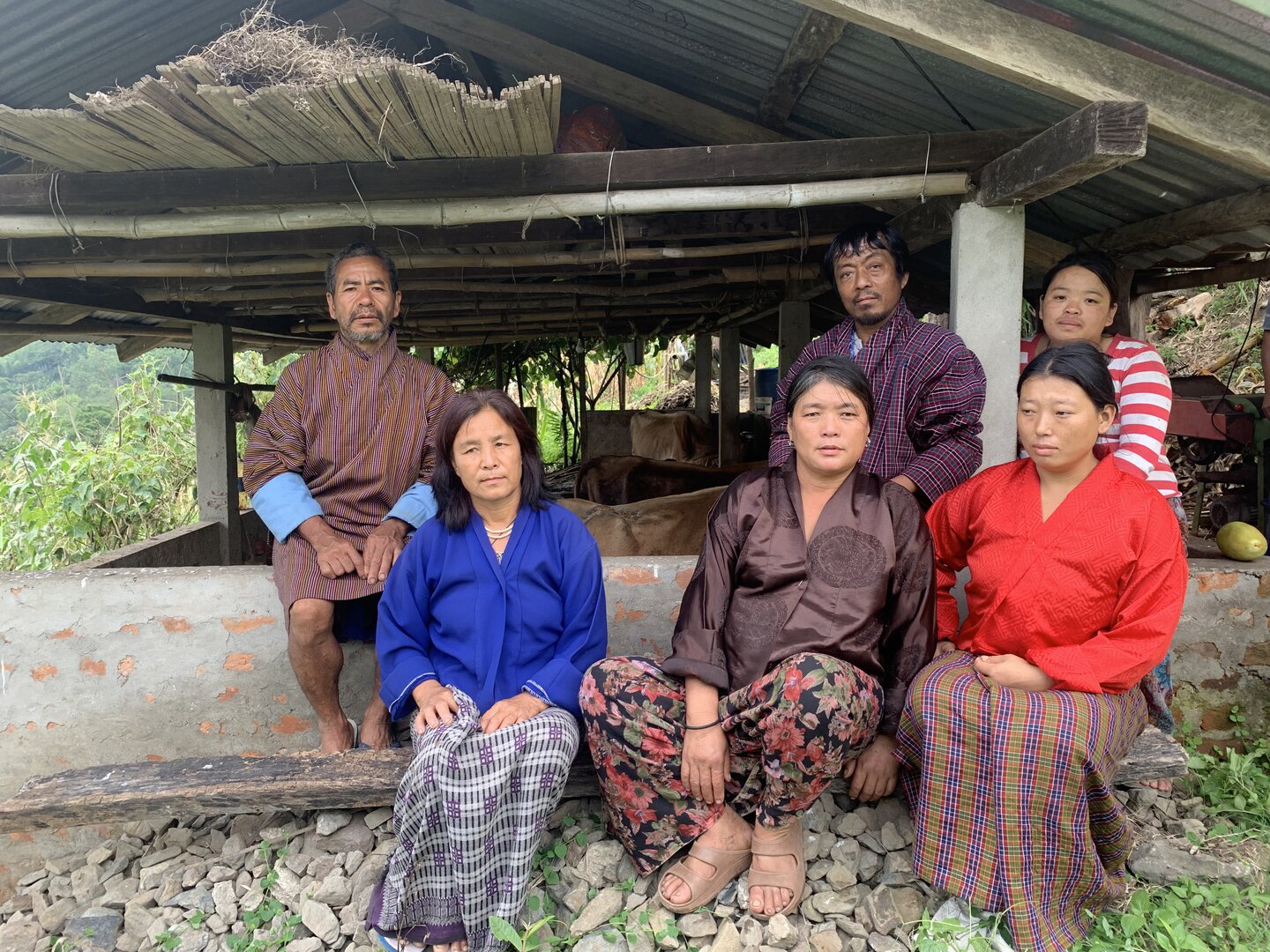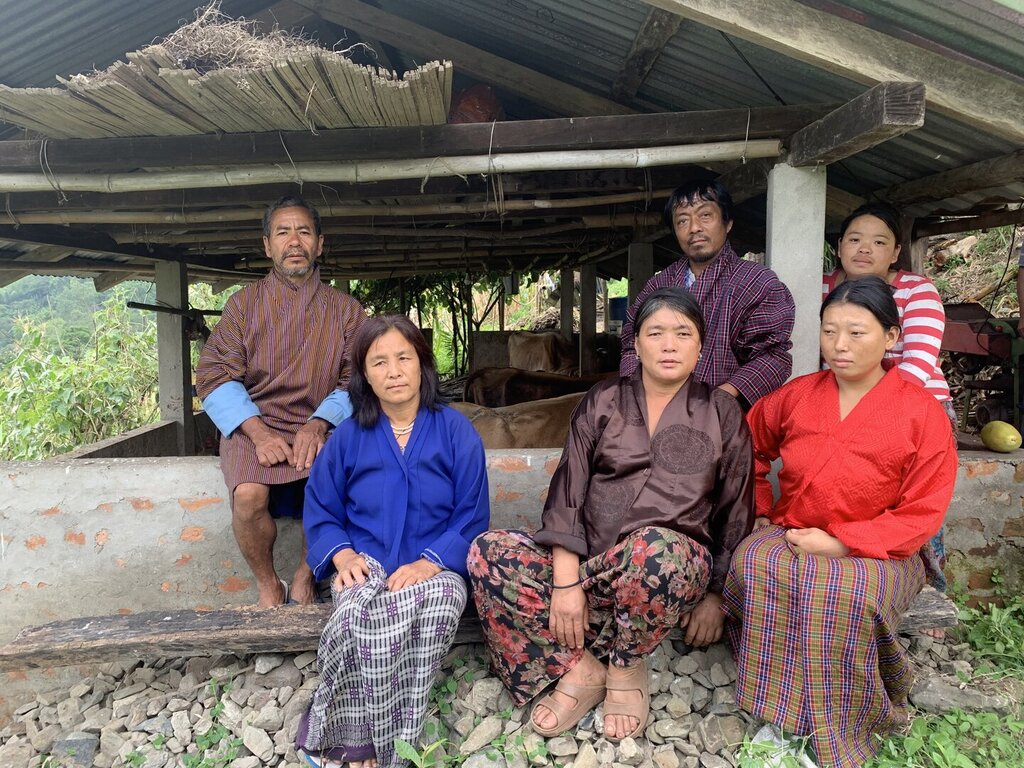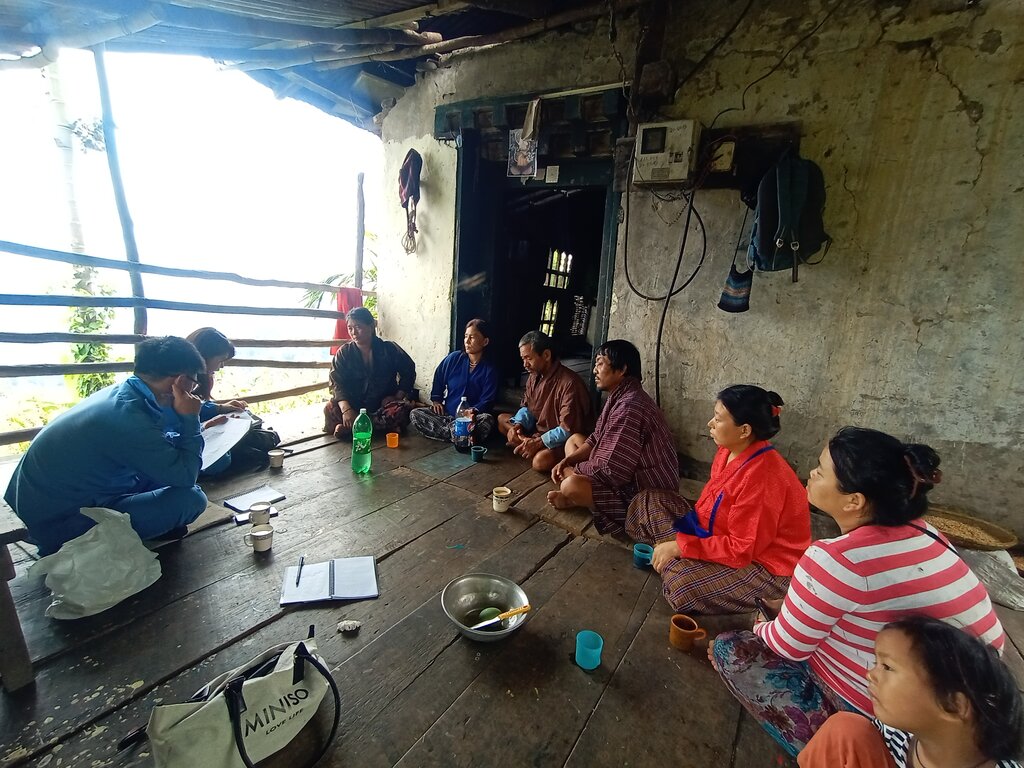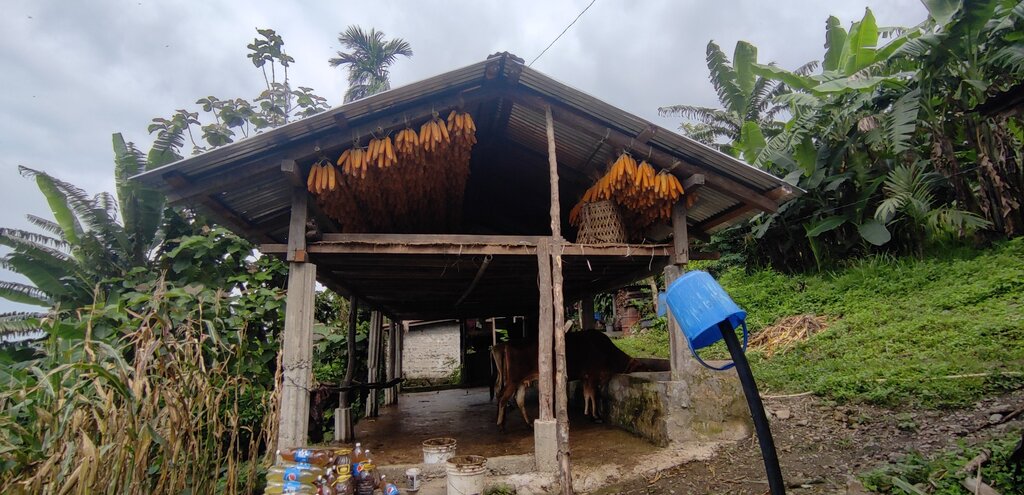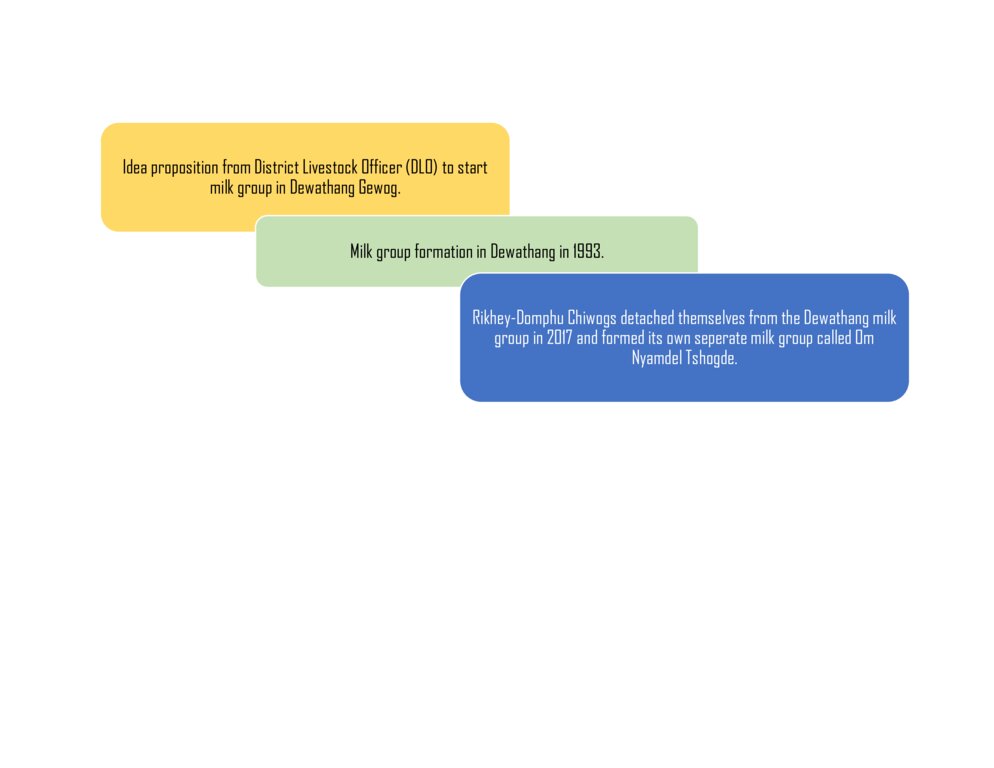Improved Livestock Farming System [ບູຕານ]
- ການສ້າງ:
- ປັບປູງ:
- ຜູ້ສັງລວມຂໍ້ມູນ: Tshering Yangzom
- ບັນນາທິການ: chenga Tshering
- ຜູ້ທົບທວນຄືນ: William Critchley, Rima Mekdaschi Studer, Joana Eichenberger
Rigsar Gi Thokley Gonor Sochong Baethang (རིགས་གསར་གྱི་ཐོག་ལས་སྒོ་ནོར་གསོ་སྐྱོང་འབད་ཐངས་།)
approaches_6895 - ບູຕານ
ເບິ່ງພາກສ່ວນ
ຂະຫຍາຍທັງໝົດ ຍຸບທັງໝົດ1. ຂໍ້ມູນທົ່ວໄປ
1.2 ລາຍລະອຽດ ການຕິດຕໍ່ ຂອງບຸກຄົນທີ່ຊັບພະຍາກອນ ແລະ ສະຖາບັນ ການມີສ່ວນຮ່ວມ ໃນການປະເມີນຜົນ ແລະ ເອກະສານ ຂອງວິທີທາງ
ບຸກຄົນສຳຄັນ (ຫຼາຍຄົນ)
ຜູ້ນໍາໃຊ້ທີ່ດິນ:
Yangzom
17410001
Kheripam village, Domphu chiwog, Dewathang gewog, Samdrup Jongkhar Dzongkhag
ບູຕານ
ຜູ້ນໍາໃຊ້ທີ່ດິນ:
Zangmo Tshewang
17967451
Kheripam village, Domphu chiwog, Dewathang gewog, Samdrup Jongkhar Dzongkhag
ບູຕານ
ຜູ້ນໍາໃຊ້ທີ່ດິນ:
Wangdi
Kheripam village, Domphu chiwog, Dewathang gewog, Samdrup Jongkhar Dzongkhag
ບູຕານ
ຜູ້ນໍາໃຊ້ທີ່ດິນ:
Jampel
17940948
Kheripam village, Domphu chiwog, Dewathang gewog, Samdrup Jongkhar Dzongkhag
ບູຕານ
ຜູ້ນໍາໃຊ້ທີ່ດິນ:
Zangmo Tendel
17970719
Kheripam village, Domphu chiwog, Dewathang gewog, Samdrup Jongkhar Dzongkhag
ບູຕານ
ຜູ້ນໍາໃຊ້ທີ່ດິນ:
Wangmo Cheki
17569913
Kheripam village, Domphu chiwog, Dewathang gewog, Samdrup Jongkhar Dzongkhag
ບູຕານ
ຊື່ຂອງໂຄງການ ທີ່ອໍານວຍຄວາມສະດວກ ໃນການສ້າງເອກກະສານ ຫຼື ປະເມີນດ້ານແນວທາງ (ຖ້າກ່ຽວຂ້ອງ)
Strengthening national-level institutional and professional capacities of country Parties towards enhanced UNCCD monitoring and reporting – GEF 7 EA Umbrella II (GEF 7 UNCCD Enabling Activities_Umbrella II)ຊື່ຂອງ ສະຖາບັນການຈັດຕັ້ງ ທີ່ອໍານວຍຄວາມສະດວກ ໃນການສ້າງເອກກະສານ ຫຼື ປະເມີນແນວທາງ (ຖ້າກ່ຽວຂ້ອງ)
National Soil Services Center, Department of Agric (National Soil Services Center, Department of Agric) - ບູຕານ1.3 ເງື່ອນໄຂ ຂອງການນໍາໃຊ້ເອກກະສານຂໍ້ມູນ ຂອງ WOCAT
ເມື່ອໃດທີ່ໄດ້ສັງລວມຂໍ້ມູນ (ຢູ່ພາກສະໜາມ)?
09/07/2023
ຜູ້ສັງລວມ ແລະ ບັນດາຜູ້ຕອບແບບສອບຖາມ ຍອມຮັບໃນເງື່ອນໄຂ ການນໍາໃຊ້ຂໍ້ມູນເອກະສານ ທີ່ສ້າງຂື້ນ ໂດຍຜ່ານ ອົງການ WOCAT:
ແມ່ນ
1.4 ເອກະສານອ້າງອີງ (ຫຼາຍ) ກັບແບບສອບຖາມ (ຫຼາຍ) ເຕັກໂນໂລຢີ ຂອງດ້ານການຄຸ້ມຄອງ ດິນແບບຍືນຍົງ
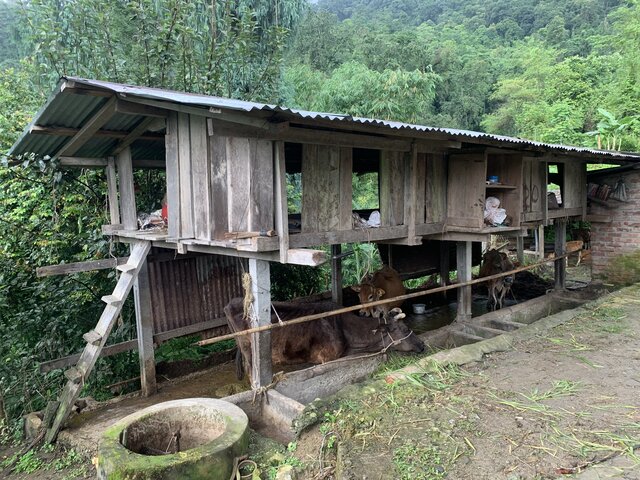
Improved Dairy Shed [ບູຕານ]
An improved dairy shed in Bhutan is characterized by concrete floors, cement pillars and troughs, enough sunlight and ventilation, adequate water, ample space for cattle movement, as well as urine and dung collection gutters and a farmyard manure collection area.
- ຜູ້ສັງລວມຂໍ້ມູນ: Tshering Yangzom
2. ພັນລະນາ ແນວທາງການຄຸ້ມຄອງນໍາໃຊ້ດິນແບບຍືນຍົງ
2.1 ການອະທິບາຍ ໂດຍຫຍໍ້ ຂອງວິທີທາງ
The approach involves a group of farmers implementing an improved dairy system. The system incorporates practices and technologies that enhance animal welfare, reduce environmental impact, and increase production.
2.2 ການອະທິບາຍ ລາຍລະອຽດ ຂອງວິທີທາງ
ການອະທິບາຍ ລາຍລະອຽດ ຂອງວິທີທາງ:
This case describes how a group approach can facilitate and encourage improved dairy production with better sheds, more productive breeds, environmental sustainability and marketing. Upgraded dairy production is described in detail under the technology “Improved dairy sheds” (T6898).
Initially, the land users were a part of a bigger milk group established in 1993. In 2017, some detached themselves and formed “Om Nyamdel Tshogde” which is a group composed of 67 members from Rikhey and Domphu chiwogs, led by a Chairperson, Mrs. Yangzom. The group also has a treasurer, Drungchen, and a driver. The main objective of forming the milk group was to improve the livelihoods of land users through higher yields via better livestock farming. The group formation process was assisted by the livestock extension officer. The funding was mobilized from the community itself.
The group members, with some support from the government, constructed improved dairy sheds, and biogas plants, and received training on fodder plantations. The stakeholders involved were land users, livestock extension officers, and the private cooperative B-COOP. The land users' role is to coordinate and conduct activities related to livestock farming. The extension officer's role is to provide veterinary and technical services. B-COOP's role is to buy dairy products from the group, especially milk.
The group members have installed improved dairy sheds with cemented floors, feeding troughs, corrugated galvanised iron (CGI) roofing, and a continuous water supply. Also, cattle have access to timely veterinary services. Cow dung and urine are used as fertilizers and also in biogas plants. Biogas plants generate renewable energy (methane), thereby cutting down the use of liquefied petroleum gas (LPG) gas which is derived from fossil fuel.
Under improved dairy sheds, stall-feeding is practised which bars the cattle from going to forests to feed. This prevents the degradation of land by cattle movement through trampling. For better nutrition and feeding, grass fodder species including Super Napier (pakchung), Napier, and Guatemala are grown, cut and and fed to cattle. In addition, other feeds provided included banana stems, maize stems, maize powder, mustard cake, and processed feeds. The group delivers at least 300 litres of milk per day to B-COOP, and some milk goes to India.
Improved breeds have replaced numerous low-yielding local cattle thereby making more efficient use of cattle feed. Also, fewer, more productive animals help reduce environmental degradation and methane losses to the atmosphere. The majority of cattle reared have been bred through artificial insemination. Most cattle are 50:50 hybrids between local breeds and improved breeds such as Jersey. Improving the breeds helps to increase milk production (e.g Holstein Friesian) and or percentage butter fat (e.g. Jersey). To feed and sustain productive, improved breeds, various fodder species are cultivated in large areas. This helps in carbon sequestration and preventing soil erosion.
What the land users like about the approach is that improved livestock farming results in a continuous source of income, as milk production is not seasonal like vegetable production, it provides organic fertilizers for fields, improves livelihoods, makes use of waste such as cow dung in biogas plants which means reduced dependency on LPG gas which is quite expensive. Also access to credit is increased. Government support has increased after the milk group formation. Furthermore, the workload is shared among the land users, especially during the making of biogas plants, thus easing the workload per person.
2.3 ຮູບພາບຂອງແນວທາງ
2.4 ວີດີໂອ ຂອງວິທີທາງ
ຄວາມຄິດເຫັນ, ຄໍາອະທິບາຍຫຍໍ້:
Cattle feeding inside an improved dairy shed
https://youtu.be/ZxV-PbV6UXY
ວັນທີ:
09/07/2023
ສະຖານທີ່:
Kheripam village, Domphu chiwog, Dewathang gewog, Samdrup Jongkhar Dzongkhag
ຊື່ຂອງຜູ້ຖ່າຍວີດີໂອ:
Nima Dolma Tamang
2.5 ປະເທດ / ເຂດ / ສະຖານທີ່ບ່ອນທີ່ແນວທາງໄດ້ຖືກນໍາໃຊ້
ປະເທດ:
ບູຕານ
ພາກພື້ນ / ລັດ / ແຂວງ:
Kheripam village, Domphu chiwog, Dewathang gewog, Samdrup Jongkhar Dzongkhag
Map
×2.6 ວັນທີເລີ່ມຕົ້ນ ແລະ ສິ້ນສຸດ ການຈັດຕັ້ງປະຕີບັດ ວິທີທາງ
ສະແດງປີຂອງການເລີ່ມຕົ້ນ:
2017
ຄວາມຄິດເຫັນ:
The approach is ongoing with no fixed termination date. The approach shall continue as long as it seems to help the land users.
2.7 ປະເພດຂອງແນວທາງ
- ການລິເລີ່ມ ພາຍໃນປະເທດ ທີ່ຜ່ານມາ / ນະວັດຕະກໍາ
2.8 ເປົ້າໝາຍ / ຈຸດປະສົງຫຼັກ ຂອງການຈັດຕັ້ງປະຕິບັດ ວິທີທາງ
The main aims of the approach are to enhance the overall well-being of animals, optimize animal production, minimize forest grazing and promote continuous stall feeding, increase the availability of FYM and urine for application to fields, develop pasture with fodder grasses, foster efficient waste utilization, provide a comfortable working environment for land users, and improve the livelihoods of land users through higher yields and better household income.
2.9 ເງື່ອນໄຂອໍານວຍ ຫຼື ຂັດຂວາງການປະຕິບັດຂອງເຕັກໂນໂລຢີ / ເຕັກໂນໂລຢີການນໍາໃຊ້ຕາມແນວທາງ
ມີຄວາມສາມາດ / ເຂັ້າເຖິງຊັບພະຍາກອນດ້ານການເງິນ ແລະ ການບໍລິການ
- ອໍານວຍ
There is assured monthly income for the land users due to the supply of milk to B-COOP and India.
ການກໍ່ຕັ້ງສະຖາບັນ
- ອໍານວຍ
There is assured monthly income for the land users due to the supply of milk and other dairy products to B-COOP and India. This has helped improve the livelihoods of land users through higher yields and better household income.
ການຮ່ວມມື / ການປະສານງານຂອງຜູ້ກ່ຽວຂ້ອງ
- ອໍານວຍ
There is labour sharing in the group (for example in the construction of biogas plants) thereby easing the workload in the group. The milk group is collectively run by the land users. Every land user is equally involved in meetings related to the group. The land users also share experiences and ideas, resulting in continuous improvement. All these enhance collaboration/coordination among the land users.
ນະໂຍບາຍ
- ອໍານວຍ
The government has supported the land users by providing deep freezers and other livestock farming construction materials free of cost.
ຄວາມຮູ້ກ່ຽວກັບການຄຸ້ມຄອງ ທີ່ດິນແບບຍືນຍົງ, ການເຂົ້າເຖິງການສະໜັບສະໜູນ ທາງດ້ານວິຊາການ
- ອໍານວຍ
The land users realize the importance of improved livestock farming systems and biogas plants. They also have access to advisory services from the livestock extension officer.
ຕະຫຼາດ (ໃນການຊື້ວັດຖຸດິບ, ຂາຍຜະລິດຕະພັນ) ແລະ ລາຄາ
- ອໍານວຍ
The group sells dairy products to Bhutan (B-COOP) and India, especially milk and generates income. The group has access to different markets which might have been difficult for individual farmers to have access to.
ວຽກ, ມີກໍາລັງຄົນ
- ອໍານວຍ
There is labour-sharing in the group (for example in the construction of biogas plants) thereby easing the workload in the group.
3. ການມີສ່ວນຮ່ວມ ແລະ ບົດບາດຂອງພາກສ່ວນທີ່ກ່ຽວຂ້ອງທີ່ໄດ້ມີສ່ວນຮ່ວມ
3.1 ຜູ້ມີສ່ວນຮ່ວມ ໃນວິທີທາງ ແລະ ພາລະບົດບາດ ຂອງເຂົາເຈົ້າ
- ຜູ້ນໍາໃຊ້ດິນໃນທ້ອງຖິ່ນ / ຊຸມຊົນທ້ອງຖິ່ນ
The land users of Rikhey-Domphu chiwogs.
Collectively produce milk (at least 300 L/day).
- ຜູ້ຊ່ຽວຊານ ການນຄຸ້ມຄອງ ທີ່ດິນແບບຍືນຍົງ / ທີ່ປຶກສາດ້ານກະສິກໍາ
Livestock extension officer.
Provide technical support to land users.
- ພາກເອກະຊົນ
Bhutan Cooperative (B-COOP)
Buy milk from the group.
3.2 ການມີສ່ວນຮ່ວມຂອງຜູ້ນໍາໃຊ້ທີ່ດິນໃນທ້ອງຖິ່ນ / ຊຸມຊົນທ້ອງຖິ່ນໃນໄລຍະທີ່ແຕກຕ່າງກັນຂອງແນວທາງ
| ການລວບລວມ ເອົາຜູ້ນໍາໃຊ້ດິນ ໃນທ້ອງຖິ່ນ / ຊຸມຊົນທ້ອງຖິ່ນ | ໃຫ້ລະບຸ ຜູ້ໃດທີ່ມີສ່ວນຮ່ວມ ໃນແຕ່ລະກິດຈະກໍາ? | |
|---|---|---|
| ການເລີ່ມຕົ້ນ / ແຮງຈູງໃຈ | ການຊ່ວຍເຫຼືອຈາກພາຍນອກ | The livestock extension officer proposed the formation of the milk group. |
| ການວາງແຜນ | ການຮ່ວມມື | The livestock officer and land users planned the group management plan. |
| ການປະຕິບັດ | ການນໍາໃໍຊ້ເອງ | The land users carried out the fieldwork of producing milk and constructing improved dairy sheds and biogas plants. |
| ຕິດຕາມກວດກາ / ການປະເມີນຜົນ | ການນໍາໃໍຊ້ເອງ | The land users monitor their group activities. |
3.3 ແຜນວາດ (ຖ້າມີ)
3.4 ການຕັດສິນໃຈກ່ຽວກັບການຄັດເລືອກເຕັກໂນໂລຢີຂອງການຄຸ້ມຄອງທີ່ດິນແບບຍືນຍົງ / ເຕັກໂນໂລຢີ
ລະບຸ ຄົນທີ່ຕັດສິນໃຈ ກ່ຽວກັບການຄັດເລືອກຂອງ ເຕັກໂນໂລຢີ / ເຕັກໂນໂລຢີ ຈະໄດ້ຮັບການປະຕິບັດ:
- ຜູ້ນໍາໃຊ້ທີ່ດິນຫຼັກ, ການສະໜັບສະໜູນ ໂດຍຜູ້ຊ່ຽວຊານ ການນໍາໃຊ້ທີ່ດິນແບບຍືນຍົງ
ອະທິບາຍ:
Mainly land users supported by the livestock officer.
Specify on what basis decisions were made:
- ປະເມີນເອກກະສານ ຄວາມຮູ້ກ່ຽວກັບ ການຄຸ້ມຄອງ ທີ່ດິນແບບຍືນຍົງ (ຫຼັກຖານທີ່ຊ່ວຍໃນການຕັດສິນໃຈ)
4. ການສະໜັບສະໜູນທາງດ້ານວິຊາການ, ການສ້າງຄວາມສາມາດ, ແລະ ການຈັດການຄວາມຮູ້.
4.1 ການສ້າງຄວາມສາມາດ / ການຝຶກອົບຮົມ
ຜູ້ນໍາໃຊ້ທີ່ດິນ ຫຼື ພາກສ່ວນກ່ຽວຂ້ອງອື່ນໆ ໄດ້ຮັບການຝຶກອົບຮົມບໍ່?
ແມ່ນ
ໃຫ້ລະບຸ ຜູ້ໃດທີ່ໄດ້ຮັບການຝຶກອົບຮົມ:
- ຜູ້ນໍາໃຊ້ດິນ
ຖ້າເປັນໄປໄດ້, ໃຫ້ລະບຸເພດ, ອາຍຸ, ສະຖານະພາບ, ຊົນເຜົ່າ, ແລະ ອື່ນໆ:
Both male and female.
ຮູບແບບຂອງການຝຶກອົບຮົມ:
- ຕົວຕໍ່ຕົວ
- ເນື້ອທີ່ສວນທົດລອງ
- ກອງປະຊຸມ
ໃນຫົວຂໍ້:
-Biogas plant construction
-Fodder grass plantation
4.2 ການບໍລິການໃຫ້ຄໍາປຶກສາ
ເຮັດຜູ້ໃຊ້ທີ່ດິນມີການເຂົ້າເຖິງການບໍລິການໃຫ້ຄໍາປຶກສາ?
ແມ່ນ
ລະບຸວ່າການສະໜອງ ການບໍລິການ ໃຫ້ຄໍາປຶກສາ:
- ໃນພື້ນທີ່ຂອງຜູ້ນໍາໃຊ້ດິນ
- ສູນຄົ້ນຄວ້າ
ອະທິບາຍ / ຄວາມຄິດເຫັນ:
The land users have access to advisory services from the livestock extension agent.
4.3 ສະຖາບັນການສ້າງຄວາມເຂັ້ມແຂງ (ການພັດທະນາອົງການຈັດຕັ້ງ)
ສະຖາບັນ ໄດ້ຮັບການສ້າງຕັ້ງຂື້ນ ຫຼື ໄດ້ຮັບການສ້າງຄວາມເຂັ້ມແຂງ ໂດຍການຈັດຕັ້ງປະຕິບັດ ວິທີທາງບໍ່?
- ມີ, ຫຼາຍ
ລະບຸ ທາງສະຖາບັນ ໄດ້ສ້າງຄວາມເຂັ້ມແຂງ ໃນລະດັບໃດ (ຫຼາຍ):
- ທ້ອງຖິ່ນ
ອະທິບາຍ ສະຖາບັນການຈັດຕັ້ງ, ພາລະບົດບາດ ແລະ ໜ້າທີ່ຮັບຜິດຊອບ, ສະມາຊິກ ແລະ ອື່ນໆ.
There is assured monthly income for the land users due to the sell of milk and other dairy products such as cheese and butter.
ລະບຸ ປະເພດ ຂອງສະໜັບສະໜູນ:
- ທາງດ້ານການເງິນ
4.4 ຕິດຕາມກວດກາ ແລະ ປະເມີນຜົນ
ການຈັດຕັ້ງປະຕິບັດ ວິທີທາງ ໄດ້ມີການປະເມີນຜົນ ແລະ ຕິດຕາມບໍ?
ແມ່ນ
ຖ້າແມ່ນ, ເອກກະສານສະບັບນີ້ ແມ່ນໄດ້ນໍາໃຊ້ເຂົ້າໃນການຕິດຕາມ ແລະ ປະເມີນຜົນບໍ່?
ບໍ່ແມ່ນ
4.5 ການຄົ້ນຄວ້າ
ນີ້້ແມ່ນສ່ວນໜຶ່ງ ການຄົ້ນຄວ້າ ຂອງວິທີທາງບໍ່?
ບໍ່ແມ່ນ
5. ການສະໜັບສະໜູນທາງດ້ານການເງິນ ແລະ ອຸປະກອນຈາກພາຍນອກ
5.1 ງົບປະມານປະຈໍາປີ ສໍາລັບວິທີທາງ ຂອງການຄຸ້ມຄອງ ທີ່ດິນແບບຍືນຍົງ
ຖ້າຫາກບໍ່ຮູ້ຈັດງົບປະມານທີ່ແນ່ນອນ ແມ່ນໃຫ້ປະມານເອົາ:
- < 2,000
ຄໍາເຫັນ (ຕົວຢ່າງ: ແຫຼ່ງຂໍ້ມູນຫຼັກ ຂອງການສະໜອງທຶນ / ຜູ້ໃຫ້ທຶນທີ່ສໍາຄັນ):
There is no annual budget allocated for the construction of improved dairy sheds and biogas plants. For biogas plant construction, pipes, metals, and 15 bags of cement were provided to land users by the government. For dairy shed construction, roofing material (18 CGI sheets) and 18 bags of cement were provided. These materials were provided by the government only once. There is no annual providing of materials or money to the land users.
5.2 ການສະໜັບສະໜູນ ທາງດ້ານການເງິນ / ອຸປະກອນ ສະໜອງໃຫ້ແກ່ຜູ້ນໍາທີ່ດິນ
ຜູ້ນໍາໃຊ້ດິນ ໄດ້ຮັບການສະໜັບສະໜູນ ທາງດ້ານ ການເງິນ / ອຸປະກອນ ໃນການຈັດຕັ້ງປະຕິບັດ ເຕັກໂນໂລຢີບໍ?
ແມ່ນ
ຖ້າແມ່ນ, ໃຫ້ລະບຸປະເພດ (ຫຼາຍ) ຂອງການສະໜັບສະໜູນ, ເງື່ອນໄຂ ແລະ ຜູູ້ສະໜອງ (ຫຼາຍ):
For biogas plant construction, pipes, metals, and 15 bags of cement were provided to land users by the government. For dairy shed construction, roofing material (18 CGI sheets) and 18 bags of cement were provided. Also, deep freezers were provided to the land users.
5.3 ເງິນສົມທົບສໍາລັບການນໍາໃຊ້ສະເພາະປັດໃຈຂາເຂົ້າໃນການຜະລີດກະສິກໍາ (ລວມທັງແຮງງານ)
- ອຸປະກອນ
| ໃຫ້ລະບຸໄດ້ຮັບການສະໜັບສະໜູນປັດໃຈຂາເຂົ້າຫຍັງແດ່ | ທີ່ຂອບເຂດ | ລະບຸ ການອຸດໜູນ |
|---|---|---|
| ງົບປະມານເຕັມສ່ວນ | Deep freezers | |
- ການກໍ່ສ້າງ
| ໃຫ້ລະບຸໄດ້ຮັບການສະໜັບສະໜູນປັດໃຈຂາເຂົ້າຫຍັງແດ່ | ທີ່ຂອບເຂດ | ລະບຸ ການອຸດໜູນ |
|---|---|---|
| ງົບປະມານບາງສ່ວນ | Cement bags CGI sheets Pipes Metals A part of these materials was financed by the government. | |
ຖ້າແຮງງານ ຂອງຜູ້ນໍາໃຊ້ດິນ ໄດ້ຮັບການສະໜັບສະໜູນ ປັດໃຈຂາເຂົ້າ, ແມ່ນບໍ່:
- ການອາສາ
5.4 ສິນເຊື່ອ
ໄດ້ປ່ອຍສິນເຊື່ອ ສະໜອງໃຫ້ພາຍໃຕ້ ວິທີການສໍາລັບກິດຈະກໍາ ການຄຸ້ມຄອງ ທີ່ດິນແບບຍືນນຍົງບໍ່?
ແມ່ນ
ເງື່ອນໄຂກໍານົດ (ອັດຕາດອກເບ້ຍ, ຈ່າຍຄືນ, ແລະ ອື່ນໆ) :
Nu 20,000 credit
ລະບຸ ການໃຫ້ບໍລິການ ການປ່ອຍສິນເຊື່ອ:
BDBL
ລະບຸ ຜູ້ທີ່ໄດ້ຮັບສິນເຊື່ອ:
Land users
5.5 ສິ່ງຈູງໃຈ ຫຼື ເຄື່ອງມືອື່ນໆ
ການສົ່ງເສີມ ຈັດຕັ້ງປະຕິບັດ ເຕັກໂນໂລຢີ ໃນການຄຸ້ມຄອງ ດິນແບບຍືນຍົງ ໄດ້ສະໜອງສິ່ງກະຕຸກຊຸກຍູ້ບໍ່?
ບໍ່ແມ່ນ
6. ວິເຄາະຜົນກະທົບ ແລະ ສັງລວມບັນຫາ
6.1 ຜົນກະທົບຂອງແນວທາງ
There is assured monthly income for the land users due to the sale of milk and this has empowered them to produce more milk to earn more money. There is labour sharing in the group (for example in the construction of biogas plants) thereby easing the workload in the group. The milk group is collectively run by the land users. Every land user is equally involved in meetings related to the group. The land users also share experiences and ideas, resulting in continuous improvement. All these enhance collaboration/coordination among the land users (stakeholders).
There is assured monthly income for the land users due to the sale of milk and this has enabled the land users to continue with stall feeding practices and pasture establishment to produce more milk to earn more money.
ການຈັດຕັ້ງປະຕິບັດ ວິທີທາງ ສາມາດຊ່ວຍຜູ້ນໍາໃຊ້ທີ່ດິນ ໃນການຈັດຕັ້ງປະຕິບັດ ແລະ ບໍາລຸງຮັກສາ ເຕັກໂນໂລຢີ ການຄຸ້ມຄອງ ທີ່ດິນແບບຍືນຍົງໄດ້ບໍ?
- ບໍ່
- ມີ, ໜ້ອຍໜຶ່ງ
- ມີ, ພໍສົມຄວນ
- ມີ, ຫຼາຍ
Improved livestock farming system has promoted technologies such as improved dairy sheds and biogas plants.
ການນໍາໃຊ້ ວິທີທາງ ສາມາດປັບປຸງຄວາມຮູ້ ແລະ ຄວາມສາມາດຂອງຜູ້ນໍາໃຊ້ທີ່ດິນ ໃນການປະຕິບັດ ການຄຸ້ມຄອງ ທີ່ດິນແບບຍືດຍົງໄດ້ບໍ່?
- ບໍ່
- ມີ, ໜ້ອຍໜຶ່ງ
- ມີ, ພໍສົມຄວນ
- ມີ, ຫຼາຍ
The land users have adopted technologies such as improved dairy sheds and biogas plants.
ການນໍາໃຊ້ ວິທີທາງ ສາມາດສ້າງຄວາມເຂັ້ມແຂງ ໃຫ້ສະຖາບັນການຈັດຕັ້ງ, ການຮ່ວມມື ລະຫວ່າງພາກສ່ວນທີ່ກ່ຽວຂ້ອງບໍ່?
- ບໍ່
- ມີ, ໜ້ອຍໜຶ່ງ
- ມີ, ພໍສົມຄວນ
- ມີ, ຫຼາຍ
The land users have been able to sell milk and other dairy products to B-COOP and India and this has helped the land users generate income. Also, B-COOP and India have benefitted from the continuous milk supply from the milk group. The milk group has helped in forming a partnership between the land users and the buyers.
ການນໍາໃຊ້ ວິທີທາງ ສາມາດຫຼຸດຜ່ອນ ຂໍ້ຂັດແຍ່ງໄດ້ບໍ່?
- ບໍ່
- ມີ, ໜ້ອຍໜຶ່ງ
- ມີ, ພໍສົມຄວນ
- ມີ, ຫຼາຍ
The land users have developed pasture land of Super Napier, Napier, and Guatemala grasses for stall feeding of cattle. This has minimized the issue of cattle entering other land users' fields and foraging on the crops.
ການຈັດຕັ້ງປະຕິບັດ ວິທີທາງ ສາມາດສ້າງຄວາມເຂັ້ມແຂງ ທາງສັງຄົມ ແລະ ເສດຖະກິດບໍ່?
- ບໍ່
- ມີ, ໜ້ອຍໜຶ່ງ
- ມີ, ພໍສົມຄວນ
- ມີ, ຫຼາຍ
Land users from different backgrounds are now part of the milk group.
ການຈັດຕັ້ງປະຕິບັດ ວິທີທາງ ສາມາດປັບປຸງ ຄວາມສະເໜີພາບ ຂອງບົດບາດ ຍິງຊາຍ ແລະ ສ້າງຄວາມເຂັ້ມແຂງໃຫ້ຜູ້ຍິງໄດ້ບໍ່?
- ບໍ່
- ມີ, ໜ້ອຍໜຶ່ງ
- ມີ, ພໍສົມຄວນ
- ມີ, ຫຼາຍ
Land users in the milk group are a mix of males and females. There is no gender discrimination.
ການນໍາໃຊ້ ວິທີທາງ ໄດ້ປັບປຸງ ການຄໍ້າປະກັນສະບຽງອາຫານ ຫຼື ປັບປຸງໂຄສະນາການໄດ້ບໍ່?
- ບໍ່
- ມີ, ໜ້ອຍໜຶ່ງ
- ມີ, ພໍສົມຄວນ
- ມີ, ຫຼາຍ
Land users have assured monthly income due to the sale of milk and other dairy products. This has led to better household income. Also, stall feeding under an improved dairy shed has promoted the cultivation of fodder of good quality and variety leading to increased and quality milk production.
ການຈັດຕັ້ງປະຕິບັດ ວິທີທາງ ສາມາດປັບປຸງ ການເຂົ້າເຖິງຕະຫຼາດໄດ້ບໍ?
- ບໍ່
- ມີ, ໜ້ອຍໜຶ່ງ
- ມີ, ພໍສົມຄວນ
- ມີ, ຫຼາຍ
Land users now sell milk and other dairy products to B-COOP and India.
ການນໍາໃຊ້ ວິທີທາງ ໄດ້ປັບປຸງ ການນໍາໃຊ້ແຫຼ່ງພະລັງງານ ແບບຍືນຍົງຫຼາຍຂື້ນບໍ່?
- ບໍ່
- ມີ, ໜ້ອຍໜຶ່ງ
- ມີ, ພໍສົມຄວນ
- ມີ, ຫຼາຍ
Biogas plants have reduced the use of LPG in some households.
ການນໍາໃຊ້ ວິທີທາງ ໄດ້ປັບປຸງ ການຈ້າງງານ, ໂອກາດ ໃນການສ້າງລາຍຮັບບໍ່?
- ບໍ່
- ມີ, ໜ້ອຍໜຶ່ງ
- ມີ, ພໍສົມຄວນ
- ມີ, ຫຼາຍ
Group marketing has helped land users earn better.
6.2 ແຮງຈູງໃຈຫຼັກຂອງຜູ້ນໍາໃຊ້ທີ່ດິນໃນການປະຕິບັດການຄຸ້ມຄອງທີ່ດິນແບບຍືນຍົງ
- ການຜະລິດເພີ່ມຂຶ້ນ
The improved dairy shed has improved the quality and quantity of milk.
- ກໍາໄລເພີ່ມຂຶ້ນ (ຄວາມສາມາດ), ການປັບປຸງຄ່າໃຊ້ຈ່າຍ, ຜົນປະໂຫຍດ, ອັດຕາສ່ວນ
There is assured monthly income for the land users.
- ຫຼຸດຜ່ອນດິນເຊື່ອມໂຊມ
Application of FYM to the field results in an increase in organic matter and an increase in nutrient availability in fields. There is better soil water retention by an increase in soil organic matter. Cattle urine also adds nutrients to the soil. Stall feeding under an improved dairy shed promotes the cultivation of fodder of good quality and variety. This helps maintain vegetative cover and prevent degradation of arable land. Similarly, stall feeding using crop residues from the field helps maintain vegetative cover and prevent the degradation of arable land. The land users feed fodder grasses such as Super Napier and Napier that help stabilize soil and provide ground cover. Other feeds provided to cattle include banana stems, mustard cakes, straw, Guatemala grass, and processed feeds (Karma Feeds). The use of organic fertilizers such as cow dung and urine minimizes the need for chemical fertilisers that can cause loss of beneficial soil organisms, reduced organic matter, soil acidification, and nutrient imbalances in the soil.
- ການປັບປຸງ ຄວາມຮູ້ ແລະ ຄວາມສາມາດ ຂອງການຄຸ້ມຄອງ ທີ່ດິນແບບຍືນຍົງ
-Construction of improved dairy sheds
-Construction of biogas plants
6.3 ຄວາມຍືນຍົງຂອງກິດຈະກໍາວິທີທາງ
ຜູ້ນໍາໃຊ້ ທີ່ດິນ ສາມາດສືບຕໍ່ ການຈັດຕັ້ງປະຕິບັດ ຜ່ານວິທີທາງໄດ້ບໍ່ (ໂດຍປາດສະຈາກ ການຊ່ວຍເຫຼືອ ຈາກພາກສ່ວນພາຍນອກ)?
- ບໍ່ມີ
ຖ້າ ບໍ່ ຫຼື ບໍ່ແນ່ໃຈ, ໃຫ້ອະທິບາຍ ແລະ ຄໍາເຫັນ:
-Improved dairy shed and biogas plant structures if damaged would incur some amount on restoration. They have to be maintained over the years. The cost of maintenance is borne by the land users. The land users do not deliberately save money for the restoration but are well aware of the fact that they will have to spend some amount on the maintenance and restoration whenever need be.
6.4 ຈຸດແຂງ / ຂໍ້ດີ ຂອງວິທີທາງ
| ຈຸດແຂງ / ຂໍ້ດີ / ໂອກາດໃນການນໍາໃຊ້ທີ່ດິນ |
|---|
| Government support especially to groups. |
| Easy access to market because of group formation. |
| Improved livelihood of farmers through higher farm yields and better household income. |
| Use of a renewable of energy like biogas instead of LPG. |
| Improved health and animal welfare. |
| ຈຸດແຂງ / ຈຸດດີ / ໂອກາດ ຈາກທັດສະນະຂອງຜູ້ປ້ອນຂໍ້ມູນ ຫຼື ບຸກຄົນສຳຄັນ |
|---|
| Knowledge sharing (land users can share their ideas and experiences while working in a group). |
| Improved dairy shed made of cement, gravel, and stones is more durable than the old dairy shed made from wood. |
| Availability of good quality fodder and a diverse range of forage options. |
| Increase in organic matter due to FYM application and better soil moisture retention by increased soil organic matter. |
| Reduced labour due to reduced fodder collection and herding in the forest. |
| Efficient waste utilization. |
| Reduced land degradation due to reduction in forest grazing. |
| Increased vegetation cover due to improved pasture development and reduction in forest grazing. |
| Less soil compaction through decreased trampling by animals. |
| Comfortable working environment for land users. |
6.5 ຈຸດອ່ອນ / ຂໍ້ເສຍຂອງແນວທາງ ແລະ ວິທີການແກ້ໄຂໃຫ້ເຂົາເຈົ້າ
| ຈຸດອ່ອນ ຫຼື ຂໍ້ເສຍ ຫຼື ຄວາມສ່ຽງ ໃນມຸມມອງຂອງ ຜູ້ສັງລວມຂໍ້ມູນ ຫຼື ບັນດາຜູ້ຕອບແບບສອບຖາມ | ມີວິທີການແກ້ໄຂຄືແນວໃດ? |
|---|---|
| Sometimes working in a group can be difficult. Internal conflicts and misunderstanding are common in group ventures. | Regular group meetings and guidance by extension staff. |
7. ເອກກະສານອ້າງອີງ ແລະ ຂໍ້ມູນການເຊື່ອມໂຍງ
7.1 ວິທີການ / ແຫຼ່ງຂໍ້ມູນ
- ການໄປຢ້ຽມຢາມພາກສະໜາມ, ການສໍາຫຼວດພາກສະໜາມ
6
- ການສໍາພາດ ຜູ້ນໍາໃຊ້ທີ່ດິນ
6
7.2 ເອກະສານທົ່ວໄປທີ່ສາມາດໃຊ້ໄດ້
ຫົວຂໍ້, ຜູ້ຂຽນ, ປີ, ISBN:
Thapa, L., Choden, D., & Tamang, N. B. (2019). Adoption of Improved Dairy Production Practices by Dairy and Non-Dairy Farmers’ Groups.
ມີຢູ່ໃສ?ມູນຄ່າເທົ່າໃດ?
https://www.researchgate.net/profile/Lokey-Thapa/publication/334507972_Adoption_of_Improved_Dairy_Production_Practices_by_Dairy_and_Non-_Dairy_Farmers'_Groups/links/5d2ec146299bf1547cbd248a/Adoption-of-Improved-Dairy-Production-Practices-by-Dairy-and-Non-Dairy-Farmers-Groups.pdf
ຂໍ້ມູນການເຊື່ອມຕໍ່ ແລະ ເນື້ອໃນ
ຂະຫຍາຍທັງໝົດ ຍຸບທັງໝົດການເຊື່ອມຕໍ່

Improved Dairy Shed [ບູຕານ]
An improved dairy shed in Bhutan is characterized by concrete floors, cement pillars and troughs, enough sunlight and ventilation, adequate water, ample space for cattle movement, as well as urine and dung collection gutters and a farmyard manure collection area.
- ຜູ້ສັງລວມຂໍ້ມູນ: Tshering Yangzom
ເນື້ອໃນ
ບໍ່ມີເນື້ອໃນ


